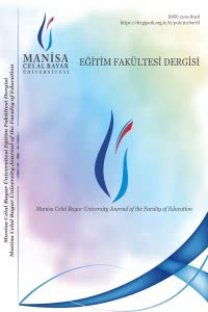Incorporating Short Stories into ELT Classes: ‘The Red Hat’ by Morley Callaghan
The aim of this study is to suggest ways of incorporating literature into ELT classes to facilitate language development with a particular focus on skills practice in a communicative manner as well as critical thinking abilities, creativity and self-expression with Morley Callaghan’s short story, The Red Hat. The study provides activities devised for this text to show how literature use can also raise awareness on cultural and gender differences, historical and political events and promote personal growth while familiarizing students with features of a literary text and exposing them to an authentic contextualized teaching /learning material. Literature offers many tools to a language student to utilize and develop in many levels and it provides opportunities for fun, meaningful, interactional and collaborative work, therefore, creates a positive learning /teaching environment. Using short stories realizes this aim in an optimal way both for the students and teachers due to their length, linguistic and literary elements when compared to other genres. Dealing with these elements in a balanced way might ensure the appreciation of the literary text while developing linguistically. The capability to finish reading an authentic work in the target language, understand and interpret it might increase the sense of achievement. This can motivate the entire classes or the individual learners to read more literary works in the class and on their own. The Red Hat by Morley Callaghan is quite appropriate to achieve the anticipated benefits of incorporation of a short story in language classes.
Anahtar Kelimeler:
Literature, Short Stories, ELT, Morley Callaghan, The Red Hat
Incorporating Short Stories into ELT Classes: ‘The Red Hat’ by Morley Callaghan
The aim of this study is to suggest ways of incorporating literature into ELT classes to facilitate language development with a particular focus on skills practice in a communicative manner as well as critical thinking abilities, creativity and self-expression with Morley Callaghan’s short story, The Red Hat. The study provides activities devised for this text to show how literature use can also raise awareness on cultural and gender differences, historical and political events and promote personal growth while familiarizing students with features of a literary text and exposing them to an authentic contextualized teaching /learning material. Literature offers many tools to a language student to utilize and develop in many levels and it provides opportunities for fun, meaningful, interactional and collaborative work, therefore, creates a positive learning /teaching environment. Using short stories realizes this aim in an optimal way both for the students and teachers due to their length, linguistic and literary elements when compared to other genres. Dealing with these elements in a balanced way might ensure the appreciation of the literary text while developing linguistically. The capability to finish reading an authentic work in the target language, understand and interpret it might increase the sense of achievement. This can motivate the entire classes or the individual learners to read more literary works in the class and on their own. The Red Hat by Morley Callaghan is quite appropriate to achieve the anticipated benefits of incorporation of a short story in language classes.
Keywords:
Literature, Short Stories, ELT, Morley Callaghan, The Red Hat,
___
- Bibby, S. & Mcllroy, T. (2013). Literature in language teaching: What, why, and how. The Language Teacher JALT SIG Special Issue, 19-21.
- Bobkina, J. (2014). The use of literature and literary texts in the EFL classroom: Between consensus and controversy. International Journal of Applied Linguistics & English Literature, 3(2), 248-260.
- Callaghan, M. (2003). The complete stories Vol 4. Toronto: Exile Editions. Collie, J. & Slater, S. (1987). Literature in the language classroom. Cambridge: Cambridge University Press.
- Erkaya, O. R. (2005). Benefits of using short stories in the EFL context. Asian EFL Journal, 8, 38-49.
- Lazar, G. (1993). Literature and language teaching. Cambridge: Cambridge University Press.
- Lima, C. (2010). Selecting literary texts for language learning. Journal of NELTA, 15(1-2), 110-113.
- Mckay, S. (1982). Literature in the ESL classroom. TESOL Quarterly,16 (4), 529-536.
- Pardede, P. (2001). Using short stories to teach language skills. Journal of English Teaching, 1(1), 14-27. DOI: 10.33541/jet.v1i1.49
- Saka, Ö. (2014). Short stories in English language teaching. International Online Journal of Education and Teaching (IOJET), 1(4), 278-288.
- Violetta-Irene, K. (2015). The use of literature in the language classroom: Methods and aims. International Journal of Information and Education Technology, 5(1), 74-79. DOI: 10.7763/ IJIET.2015.V5.479
- Yavuz, A. (2015). Culture, gender, language and literature relationship: 4th year ELT students’ perceptions of female issues in American and British literature. International Journal of Languageand Literature, 3(2), 25-34.
- Yimwilai, S. (2015). An integrated approach to teaching literature in an EFL classroom. English Language Teaching, 8(2), 14-21.
- ISSN: 1309-8918
- Yayın Aralığı: 2
- Başlangıç: 2011
- Yayıncı: MANİSA CELÂL BAYAR ÜNİVERSİTESİ
Sayıdaki Diğer Makaleler
ADDT Odaklı Grupla Psikolojik Danışmanın 8. Sınıf Öğrencilerinin Sosyal Beceri Düzeylerine Etkisi
Incorporating Short Stories into ELT Classes: ‘The Red Hat’ by Morley Callaghan
A Need Analysis Examining Teachers’ Point of Views about Cooperative Problem Solving
Öğrencilerin Sayı Duyusu Stratejilerinin Sınıf Düzeyi ve Sayı Duyusu Bileşenlerine Göre Analizi
